
Publication 1771-IN036C-EN-P - July 2002
DC (10-30V) Output Module
Cat. No. 1771–OVN Series B
This document provides information on:
See page
Important User Information 1
Preinstallation Considerations 4
Calculate Power Requirements 4
Initial Handling 5
Key the I/O Chassis 5
Install the Module and Field Wiring Arm 6
Connect Wiring to the Field Wiring Arm 7
Replacing the Fuse 10
For this reference information See page
Intepreting the Status Indicators 10
Hazardous Location Approval 11
Specifications 12
Because of the variety of uses for the products described in this
publication, those responsible for the application and use of these
products must satisfy themselves that all necessary steps have been
taken to assure that each application and use meets all performance
and safety requirements, including any applicable laws, regulations,
codes and standards. In no event will Rockwell Automation be
responsible or liable for indirect or consequential damage resulting
from the use or application of these products.
Any illustrations, charts, sample programs, and layout examples
shown in this publication are intended solely for purposes of
example. Since there are many variables and requirements associated
with any particular installation, Rockwell Automation does not
assume responsibility or liability (to include intellectual property
liability) for actual use based upon the examples shown in this
publication.
Important User Information
Installation Instructions
To The Installer

DC (10–30V) Output Module2
Publication 1771-IN036C-EN-P - July 2002
Allen–Bradley publication SGI–1.1, Safety Guidelines for
Application, Installation, and Maintenance of Solid–State Control
(available from your local Rockwell Automation office), describes
some important differences between solid–state equipment and
electromechanical devices that should be taken into consideration
when applying products such as those described in this publication.
Reproduction of the contents of this copyrighted publication, in
whole or part, without written permission of Rockwell Automation,
is prohibited.
Throughout this publication, notes may be used to make you aware
of safety considerations. The following annotations and their
accompanying statements help you to identify a potential hazard,
avoid a potential hazard, and recognize the consequences of a
potential hazard.
WARNING
!
Identifies information about practices or
circumstances that can cause an explosion in a
hazardous environment, which may lead to
personal injury or death, property damage, or
economic loss.
ATTENTION
!
Identifies information about practices or
circumstances that may lead to personal injury or
death, property damage, or economic loss.
IMPORTANT
Identifies information that is critical for
successful application and understanding of the
product.

DC (10–30V) Output Module 3
Publication 1771-IN036C-EN-P - July 2002
ATTENTION
!
Environment and Enclosure
This equipment is intended for use in a Pollution
Degree 2 industrial environment, in overvoltage
Category II applications (as defined in IEC
publication 60664–1), at altitudes up to 2000
meters without derating.
This equipment is considered Group 1, Class A
industrial equipment according to IEC/CISPR
Publication 11. Without appropriate precautions,
there may be potential difficulties ensuring
electromagnetic compatibility in other
environments due to conducted as well as radiated
disturbance.
This equipment is supplied as “open type”
equipment. It must be mounted within an
enclosure that is suitably designed for those
specific environmental conditions that will be
present, and appropriately designed to prevent
personal injury resulting from accessibility to live
parts. The interior of the enclosure must be
accessible only by the use of a tool. Subsequent
sections of this publication may contain additional
information regarding specific enclosure type
ratings that are required to comply with certain
product safety certifications.
See NEMA Standards publication 250 and IEC
publication 60529, as applicable, for explanations
of the degrees of protection provided by different
types of enclosures. Also, see the appropriate
sections in this publication, as well as the
Allen–Bradley publication 1770–4.1, (“Industrial
Automation Wiring and Grounding Guidelines”),
for additional installation requirements pertaining
to this equipment.

DC (10–30V) Output Module4
Publication 1771-IN036C-EN-P - July 2002
!
ATTENTION
Preventing Electrostatic Discharge
This equipment is sensitive to electrostatic
discharge, which can cause internal damage and
affect normal operation. Follow these guidelines
when you handle this equipment:
• Touch a grounded object to discharge potential
static.
• Wear an approved grounding wriststrap.
• Do not touch connectors or pins on component
boards.
• Do not touch circuit components inside the
equipment.
• If available, use a static–safe workstation.
• When not in use, keep modules in appropriate
static–safe packaging.
The Series B 1771-OVN dc output module is a sink output and
requires a source input. A source input provides a positive voltage
path and a sink output provides a path to ground.
You must use this module in a 1771-A1B, -A2B, -A3B, -A3B1,
-A4B or later 1771 I/O chassis. Refer to the table below for
processor compatibility.
Table A Processor Compatibility Chart
System Type Use with Processors:
Local MiniĆPLCĆ2/02 (cat. no. 1772ĆLZ, ĆLZP)
MiniĆPLCĆ2/16 (cat. no. 1772ĆLX, ĆLXP)
MiniĆPLCĆ2/17 (cat. no. 1772ĆLW, ĆLWP)
PLCĆ5/15, Series B and later (cat. no. 1785ĆLT)
Remote (with a 1771ĆASB
remote I/O adapter)
PLCĆ2/20 (cat. no. 1772ĆLP2)
PLCĆ2/30 (cat. no. 1772ĆLP3)
PLCĆ3 (cat. no. 1775ĆL1, ĆL2, ĆL3, ĆL4)
PLCĆ3/10 (cat. no. 1775ĆLP4, ĆLP8)
PLCĆ5/15, Series B and later (cat. no. 1785ĆLT)
Do not place this module in the same I/O chassis as the 1771-IX
thermocouple module. You can use this module in the same chassis
as the 1771-IXE thermocouple module.
The controller or I/O chassis power supply, connected through the
backplane of the I/O chassis, powers the logic circuitry of the output
modules. The maximum current drawn from this supply is 330mA.
PreĆinstallation
Considerations
Calculate Power Supply
Requirements

DC (10–30V) Output Module 5
Publication 1771-IN036C-EN-P - July 2002
!
ATTENTION
Remove power from the 1771 I/O chassis
backplane and field wiring arm before removing
or installing an I/O module.
• Failure to remove power from the backplane or
wiring arm could cause module damage,
degradation of performance, or injury.
• Failure to remove power from the backplane
could cause injury or equipment damage due to
possible unexpected operation.
!
ATTENTION
A module inserted into a wrong slot could be
damaged by improper voltages connected through
the wiring arm. Use keying bands to prevent
damage to the module.
Place your module in any slot in the chassis
except the leftmost slot, which is reserved for
processors or adapters.
Observe the following precautions
when inserting or removing keys:
• insert or remove keys with your
fingers
• make sure that key placement is
correct
Incorrect keying or the use of a tool
can result in damage to the
backplane connector and possible
system faults.
!
ATTENTION
Position the keying bands in the backplane connectors to correspond to
the key slots on the module.
You can change the position of these bands if
subsequent system design and rewiring makes
insertion of a different type of module necessary.
Upper Connector
11022ĆI
I/O chassis
Place the keying bands:
- between 14 and 16
- between 32 and 34
The 1771–OVN module is a modular component of the 1771 I/O
system requiring a properly installed system chassis. Refer to
publication 1771–IN075 for detailed information on acceptable
chassis, proper installation and grounding requirements.
Initial Handling
Procedures
Keying the I/O Chassis

DC (10–30V) Output Module6
Publication 1771-IN036C-EN-P - July 2002
!
ATTENTION
Remove power from the 1771 I/O chassis
backplane and field wiring arm before removing
or installing an I/O module.
• Failure to remove power from the backplane or
wiring arm could cause module damage, degra-
dation of performance, or injury.
• Failure to remove power from the backplane
could cause injury or equipment damage due to
possible unexpected operation.
Swing the chassis locking bar down into place to secure
the modules. Make sure the locking pins engage.
1771ĆA1B, ĆA2B, ĆA3B, ĆA3B1, ĆA4B I/O chassis
1771ĆA1B, ĆA2B, ĆA3B1, ĆA4B Series B I/O chassis
locking tab
card guides
module
module
19809
card guides
locking bar
locking bar pin
Snap the chassis latch over
the top of the module to secure it.
17643
wiring arm
install
remove
horizontal bar
Attach the wiring arm (1771ĆWN) to the horizontal
bar at the bottom of the I/O chassis.
The wiring arm pivots upward and connects with
the module so you can install or remove the
module without disconnecting the wires.
1771ĆWN
!
WARNING
If you insert or remove the module while
backplane power is on, or you connect or
disconnect the wiring arm with field power
applied, an electrical arc can occur. This could
cause an explosion in hazardous location
installations. Be sure power is removed or the area
is nonhazardous before proceeding.
Install the Module and
Field Wiring Arm

DC (10–30V) Output Module 7
Publication 1771-IN036C-EN-P - July 2002
!
WARNING
When you connect or disconnect the wiring arm
with field power applied, an electrical arc can
occur. This could cause an explosion in hazardous
location installations. Be sure power is removed
or the area is nonhazardous before proceeding.
!
ATTENTION
Remove power from the 1771 I/O chassis
backplane and field wiring arm before removing
or installing an I/O module.
• Failure to remove power from the backplane or
wiring arm could cause module damage,
degradation of performance, or injury.
• Failure to remove power from the backplane
could cause injury or equipment damage due to
possible unexpected operation.
Make wiring connections to the module through the field wiring arm
cat. no. 1771-WN. The arm pivots on the I/O chassis to connect with
terminals on the front of the module and acts as a terminal strip. The
wiring arm allows the module to be removed from the chassis
without disconnecting wiring.
!
ATTENTION
The field wiring arm terminal identification
number is not the same as the number of the bit
which controls that output.
I/O Module Groups
Each module condenses two full module groups (32 outputs) into
each I/O chassis slot. For example:
Module group 1 = inputs 00 through 17
Module group 2 = inputs 00 through 17 (module group 2
represents the second set of outputs).
Terminals 1 through 20 represent module group 1. Terminals 21
through 40 represent module group 2. Terminals 10, 20, 30 and 40
are DC common and terminals 1, 11, 21 and 31 are DC power.
Connect Wiring to the
Module

DC (10–30V) Output Module8
Publication 1771-IN036C-EN-P - July 2002
Connection Diagram for the 1771ĆOVN/B DC Output Module
Output 0
Output 2
Output 4
Output 6
Common 0
Output 10
Output 12
Output 14
Output 16
Common 1
Output 0
Output 2
Output 4
Output 6
Common 2
Output 10
Output 12
Output 14
Output 16
Common 3
+dc
Output 1
Output 3
Output 5
Output 7
+dc
Output 11
Output 13
Output 15
Output 17
+dc
Output 1
Output 3
Output 5
Output 7
+dc
Output 11
Output 13
Output 15
Output 17
+
Ć
dc
Supply
dc Output
Device
Ć
+
Note: Terminals on the left are even
numbered (2 thru 40) , and terminals
on the right are odd numbered
(1 thru 39).
2
4
6
8
10
12
14
16
18
20
22
24
26
28
30
32
34
36
38
40
Actual wiring runs in this direction.
10435ĆI
Terminals 1 through 20 represent module group 1.
Terminals 21 through 40 represent module group 2.
Terminals 10, 20, 30 and 40 are dc common and
terminals 1, 11, 21, and 31 are dc power.
If multiple power sources are used, do not exceed the specified isolation voltage.
!
ATTENTION
Observe proper polarity, as indicated in the
connection diagram with dc power connections.
Reverse polarity, or application of ac voltage,
could damage the module.
!
ATTENTION
Miswiring or shorting the output terminals will
cause permanent damage to this module.

DC (10–30V) Output Module 9
Publication 1771-IN036C-EN-P - July 2002
Table B
Module Output Terminal Assignments
Terminal
Number
Output Assignment I/O program address
Terminal
Number
Output Assignment I/O program address
01
1
10 to 30V dc Ć 21
1
10 to 30V dc Ć
02 Output 00 0RG00 22 Output 00 0RG00
03 Output 01 0RG01 23 Output 01 0RG01
04 Output 02 0RG02 24 Output 02 0RG02
05 Output 03 0RG03 25 Output 03 0RG03
06 Output 04 0RG04 26 Output 04 0RG04
07 Output 05 0RG05 27 Output 05 0RG05
08 Output 06 0RG06 28 Output 06 0RG06
09 Output 07 0RG07 29 Output 07 0RG07
10 Common 0 Ć 30 Common 2 Ć
11
1
10 to 30V dc Ć 31
1
10 to 30V dc Ć
12 Output 10 0RG10 32 Output 10 0RG10
13 Output 11 0RG11 33 Output 11 0RG11
14 Output 12 0RG12 34 Output 12 0RG12
15 Output 13 0RG13 35 Output 13 0RG13
16 Output 14 0RG14 36 Output 14 0RG14
17 Output 15 0RG15 37 Output 15 0RG15
18 Output 16 0RG16 38 Output 16 0RG16
19 Output 17 0RG17 39 Output 17 0RG17
20 Common 1 Ć 40 Common 3 Ć
Where: R = rack number (1, 2, 3, etc.)
G = I/O group (0 Ć 7)
1
You can connect a different power supply to each 10 to 30V dc terminal. They are not connected internally. Connect each common (0, 1, 2, 3) to the corresponding
supply. Commons are not internally connected.

DC (10–30V) Output Module10
Publication 1771-IN036C-EN-P - July 2002
The module has 32 status indicators on the module front plate. These
represent the control status of the outputs. Each indicator is lit when
its corresponding output is energized. An additional indicator is
provided to indicate a blown fuse condition.
00
01
02
03
04
05
06
07
10
11
12
13
14
15
16
17
Status Indicators (red)
00
01
02
03
04
05
06
07
10
11
12
13
14
15
16
17
FUSE
Fuse Blown Indicator
10436ĆI
To replace a blown fuse, proceed as follows:
!
ATTENTION
Remove power from the 1771 I/O chassis
backplane and field wiring arm before removing
or installing an I/O module.
• Failure to remove power from the backplane or
wiring arm could cause module damage,
degradation of performance, or injury.
• Failure to remove power from the backplane
could cause injury or equipment damage due to
possible unexpected operation.
1. Turn off power to the chassis.
2. Remove the module from the I/O chassis.
3. Remove the blown fuse from the fuse holder (accessible through
side cover), and replace it with a 4A, 250V normal blow fuse.
4. Reinsert the module into the I/O chassis.
5. Turn on power to the chassis.
Interpreting the Status
Indicators
Replacing the Fuses

DC (10–30V) Output Module 11
Publication 1771-IN036C-EN-P - July 2002
The following information applies when operating this equipment in hazardous
locations:
Products marked CL I, DIV 2, GP A, B, C, D" are suitable for use in Class I Division 2
Groups A, B, C, and D Hazardous Locations and nonhazardous locations only. Each
product is supplied with markings on the rating nameplate indicating the hazardous location
temperature code. When combining products within a system, the most adverse
temperature code (lowest T" number) may be used to help determine the overall
temperature code of the system. Combinations of equipment in your system are subject to
investigation by the local Authority Having Jurisdiction at the time of installation.
!
WARNING
EXPLOSION HAZARD -
• Do not disconnect equipment unless power has been removed or
the area is known to be nonhazardous.
• Do not disconnect connections to this equipment unless power
has been removed or the area is known to be nonhazardous.
Secure any external connections that mate to this equipment by
using screws, sliding latches, threaded connectors, or other
means provided with this product.
• Substitution of components may impair suitability for Class I,
Division 2.
• If this product contains batteries, they must only be changed in an
area known to be nonhazardous.
Informations sur l'utilisation de cet équipement en environnements dangereux:
Les produits marqués CL I, DIV 2, GP A, B, C, D ne conviennent que une utilisation en
environnements de Classe I Division 2 Groupes A, B, C, D dangereux et non dangereux.
Chaque produit est livré avec des marquages sur sa plaque d'identification qui indiquent le
code de température pour les environnements dangereux. Lorsque plusieurs produits sont
combinés dans un systéme, le code de température le plus défavorable (code de
température le plus faible) peut eatre utilisé pour déterminer le code de température global
du systéme. Les combinaisons d'equipements dans le systéme sont sujettes à inspection
par les autorités locales qualifiées au moment de l'installation.
!
AVERTISSEMENT
RISQUE D'EXPLOSION -
• Couper le courant ou s'assurer que l'environnement est classé
non dangereux avant de débrancher l'équipement.
• Couper le courant ou s'assurer que l'environnement est classé
non dangereux avant de débrancher les connecteurs. Fixer tous
les connecteurs externes reliés à cet équipement à
l'aide de vis, loquets coulissants, connecteurs filetés ou autres
moyens fournis avec ce produit.
• La substitution de composants peut rendre cet équipement
inadapté à une utilisation en environnement de Classe 1, Division
2.
• S'assurer que l'environnement est classé non dangereux avant
de changer les piles.
PLC-2/02, PLC-2/05, PLC-2/16, and PLC-2/17 are trademarks of Allen-Bradley Company, Inc.

DC (10–30V) Output Module12
Publication 1771-IN036C-EN-P - July 2002
Outputs per module 32 (4 groups of 8)
Module Location 1771ĆA1B thru ĆA4B or later I/O Chassis
Voltage Rating 10 to 30V dc, 0.5A per output, 2A per group, 8A per module
Maximum Output Current Rating Maximum Output Current Rating
0.5A per output (not to exceed 8A per module)
2A per output group
Maximum Surge Current 2A per output for 10ms; repeatable every 2 seconds.
5A per output group for 10ms; repeatable every 2 seconds.
20A per module for 10ms; repeatable every 2 seconds.
Maximum OnĆstate Voltage Drop 1.5V dc at rated output current
Maximum OffĆstate Leakage Current 1.0mA @ 55
o
C
Output Signal Delay On to off propagation delay 2.0msec
Off to on propagation delay 0.1msec
Power Dissipation 13.7W (max); 1.7W (min)
Thermal Dissipation 46.7 BTU/hr (max); 5.7 BTU/hr (min)
Backplane Current 330mA @ 5V dc maximum
Isolation Voltage Tested to withstand 500V for 60s.
Conductors Wire Size
Category
14 AWG (2.5mm
2
) to 22 AWG (0.25mm
2
) (max)
1
stranded copper
rated at 60
o
C or greater
3/64 inch (1.2mm) insulation (max)
2
2
Environmental Conditions
Operating
Temperature
IEC 60068-2-1 (Test Ad, Operating Cold)
IEC 60068-2-2 (Test Bd, Operating Dry Heat)
IEC 60068-2-14 (Test Nb, Operating Thermal Shock)
32 to 104°F(0
o
to 40
o
C)
Storage Temperature IEC 60068-2-1 (Test Ab, Unpackaged, Nonoperating Cold)
IEC 60068-2-2 (Test Bb, Unpackaged, Nonoperating Dry Heat)
IEC 60068-2-14 (Test Na, Unpackaged, Nonoperating Thermal
Shock)
-40 to 185°F (-40 to 185
o
F)
Relative Humidity IEC 60068-2-30 (Test Db, Unpackaged, Nonoperating Damp Heat)
5 to 95%, noncondensing
Shock
Operating
Nonoperating
IEC 60068-2-27 (Test Ea, Unpackaged Shock)
30g
50g
Vibration IEC 60068-2-6 (Test Fc, Operating)
2g @ 10-500Hz
ESD Immunity IEC 61000-4-2
4kV indirect discharges
Radiated RF Immunity IEC 61000-4-3
10V/m, 3V/M Broadcast Bands, with 1kHz sine-wave 80% AM from
30MHz to 1000MHz
EFT/B Immunity IEC 61000-4-4
+
1kV @ 5kHz on signal ports
Surge Transient Immunity IEC 61000-4-5
+
1kV line-line (DM) and +2kV line-earth (CM) on signal ports
Conducted RF Immunity IEC 61000-4-6
10V rms with 1kHz sine wave 80% AM from 150kHz to 30MHz
Specifications continued on next page.
Specifications

Specifications
(cont.)
DC (10–30V) Output Module 13
Publication 1771-IN036C-EN-P - July 2002
Emissions CISPR 11
Group 1, Class A (with appropriate enclosure)
Enclosure Type Rating None (open-style)
Keying Between 14 and 16
Between 32 and 34
Fuse Four 4.0A, 250V normal blow fuses (1 per group); SAN-O Corporation
ST4-4.0A
Field Wiring Arm Catalog Number 1771ĆWN
Wiring Arm Screw Torque 9 pound-inches (1.0Nm)
Certifications
(when product is marked)
UL UL Listed Industrial Control Equipment
CSA CSA Certified Process Control Equipment
CSA CSA Certified Process Control Equipment for Class I,
Division 2 Group A, B, C, D Hazardous Locations
CE
3
European Union 89/336/EEC EMC Directive,
compliant with:
EN 61000-6-2, Industrial Immunity
EN 61000-6-4, Industrial Emissions
EN 50082-2, Industrial Immunity
EN 61326, Meas./Control/Lab., Industrial Requirements
C-Tick
3
Australian Radiocommunications Act, compliant with:
AS/NZS 2064, Industrial Emissions
1
14 gauge wire connected to all terminals may not allow the cover on the field wiring arm to close. A smaller gauge wire may
be used.
2
You use this conductor category information for planning conductor routing as described in publication 1770Ć4.1, Industrial
Automation Wiring and Grounding Guidelines.
3
See the Product Certification link at www.ab.com for Declarations of Conformity, Certificates and other certification details

DC (10–30V) Output Module14
Publication 1771-IN036C-EN-P - July 2002

DC (10–30V) Output Module 15
Publication 1771-IN036C-EN-P - July 2002

DC (10–30V) Output Module16
Publication 1771-IN036C-EN-P - July 2002
Publication 1771-IN036C-EN-P - July 2002
Supersedes publication 1771Ć5.36 - February 2000
PN957678-78
Copyright 2002 Rockwell Automation, Inc. Printed in USA
-
 1
1
-
 2
2
-
 3
3
-
 4
4
-
 5
5
-
 6
6
-
 7
7
-
 8
8
-
 9
9
-
 10
10
-
 11
11
-
 12
12
-
 13
13
-
 14
14
-
 15
15
-
 16
16
Allen-Bradley 1771-A3B Installation Instructions Manual
- Taper
- Installation Instructions Manual
dans d''autres langues
- English: Allen-Bradley 1771-A3B
Documents connexes
-
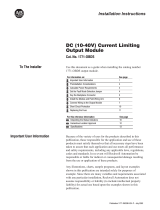 Allen-Bradley 1771-OBDS Installation Instructions Manual
Allen-Bradley 1771-OBDS Installation Instructions Manual
-
 Allen-Bradley 1757-ABRIO Installation Instructions Manual
Allen-Bradley 1757-ABRIO Installation Instructions Manual
-
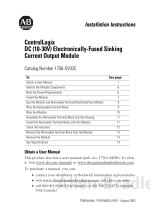 Allen-Bradley ControlLogix 1756-OV32E Installation Instructions Manual
Allen-Bradley ControlLogix 1756-OV32E Installation Instructions Manual
-
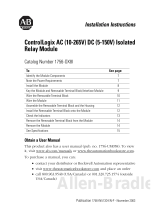 Allen-Bradley ControlLogix 1756-OX8I Installation Instructions Manual
Allen-Bradley ControlLogix 1756-OX8I Installation Instructions Manual
-
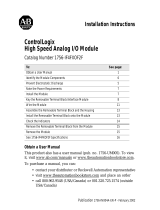 Allen-Bradley ControlLogix 1756-IF4FXOF2F Installation Instructions Manual
Allen-Bradley ControlLogix 1756-IF4FXOF2F Installation Instructions Manual
-
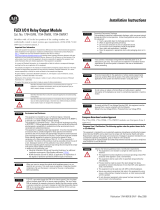 Allen-Bradley 1794-OW8 Guide d'installation
Allen-Bradley 1794-OW8 Guide d'installation
-
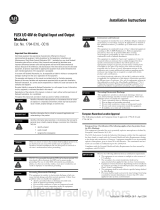 Allen-Bradley FLEX I/O 1794-IC16 Installation Instructions Manual
Allen-Bradley FLEX I/O 1794-IC16 Installation Instructions Manual
-
Allen-Bradley C Series Guide d'installation
-
Allen-Bradley 1756-OV16E Installation Instructions Manual
























